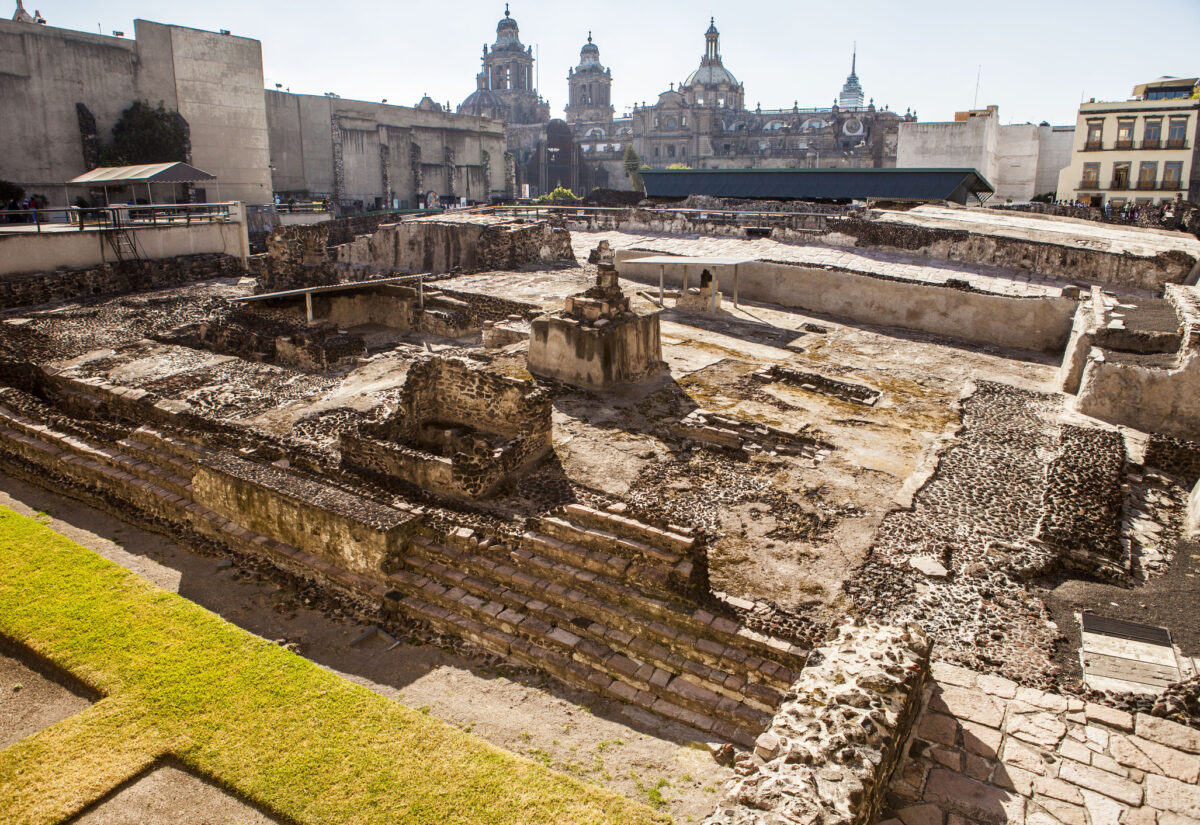 Getty Images/iStockphoto
Getty Images/iStockphotoModern cities are filled with layers of history—centuries of human activity, often hidden in plain sight. While office blocks, train stations, and shopping centres dominate skylines, tucked away behind facades or buried beneath street level are remnants of the past that have somehow survived. Many of these historical landmarks are overlooked, neglected, or simply misunderstood for what they really are. From ancient temples beneath skyscrapers to Roman ruins in basements, the stories they tell stretch across time and geography. Here are 13 fascinating historical locations around the world that are hidden in plain sight—often walked past by thousands every day, their secrets unnoticed.
London Wall, London, UK
Right in the heart of the financial district, near Moorgate and the Museum of London, stands a surviving section of the Roman London Wall. Constructed around 200 AD, this fortification once enclosed Londinium, the bustling Roman capital of Britain. While most of it has been lost to centuries of development, several pieces still stand—often squeezed between glass offices and busy car parks.
Many Londoners walk past these ancient stones daily without giving them a second glance. But they’re part of one of the most significant Roman defences ever built in Britain, and fragments can still be found in locations like Tower Hill and Barbican. Their survival is remarkable in a city that’s constantly evolving.
Temple of Mithras, London, UK
Beneath the Bloomberg building in the City of London is the restored Temple of Mithras, a Roman sanctuary dating back to the 3rd century. Originally discovered in the 1950s during building work, the temple was dismantled and later reconstructed near its original location.
Today, it’s the centrepiece of a modern museum space where visitors can descend into a dramatic, low-lit reconstruction of the temple as it might have looked in Roman times. This hidden religious site reveals the secretive cult of Mithras, popular among Roman soldiers, and lies quietly beneath one of the city’s most cutting-edge developments.
The ruins beneath Glasgow Central Station, Scotland
Glasgow Central is Scotland’s busiest railway station, but what lies beneath it is equally fascinating. Deep below the platforms, you’ll find remnants of the original 19th-century station, including disused railway tunnels, Victorian engineering marvels, and even wartime air-raid shelters.
Guided tours of these subterranean spaces reveal a forgotten world of soot-streaked brickwork and eerie echoes. There are even sections that were once used for transporting mail and goods, long before modern infrastructure took over. Most commuters pass through above, unaware of this shadowy industrial network below.
Roman amphitheatre beneath Guildhall, London, UK
Hidden underneath the Guildhall Art Gallery in the heart of London lies the preserved remains of a Roman amphitheatre. Capable of seating up to 7,000 spectators, it once hosted gladiator battles, executions, and wild animal shows. Rediscovered in the 1980s during building works, it now forms an atmospheric display beneath the gallery.
Above ground, a black circle in the Guildhall courtyard subtly marks the original arena’s outline. It’s easy to miss unless you know what to look for. The amphitheatre is one of the best-kept archaeological secrets in London’s historic core.
York’s Roman bathhouse, UK
York is steeped in history, and one of its lesser-known treasures lies beneath a pub in St Sampson’s Square. Beneath the Roman Bath pub are the remains of a Roman bathhouse, including sections of the hypocaust (underfloor heating) system and parts of the original stone walls.
Accessible to the public via a modest museum downstairs, it’s a rare opportunity to see a slice of ancient Roman domestic life hidden beneath a modern-day watering hole. Many pub-goers never realise they’re drinking just above centuries-old bathing rituals.
Basilica Cistern, Istanbul, Turkey
Only steps away from Istanbul’s famed Hagia Sophia is the unassuming entrance to the Basilica Cistern, a vast underground reservoir built in the 6th century by Emperor Justinian I. Designed to store water for the Byzantine palace, it’s supported by more than 300 marble columns.
With its vaulted ceilings and soft lighting, the cistern feels more like a cathedral than a utility. The eerie beauty is enhanced by the presence of two carved Medusa heads used as column bases. Thousands of tourists pass it by without realising such an atmospheric structure lies just below.
Templo Mayor, Mexico City, Mexico
In central Mexico City, sandwiched between colonial-era churches and bustling markets, lie the uncovered ruins of the Templo Mayor—the main temple of the Aztec capital Tenochtitlán. For centuries, it was buried beneath buildings constructed after the Spanish conquest.
Excavated in the 1970s, the site is now part open-air museum, part archaeological dig, with sections still being uncovered. Visitors can walk through what was once the spiritual heart of the Aztec empire, just steps away from one of the busiest squares in Latin America.
Domus Aurea, Rome, Italy
Built by Emperor Nero after the Great Fire of Rome in AD 64, the Domus Aurea (Golden House) was one of the most extravagant palaces in Roman history. Its memory was so detested that later emperors buried it—literally. Today, what survives lies hidden beneath a park near the Colosseum.
You can tour parts of the palace via guided visits, walking beneath ceilings still bearing traces of gold leaf and frescoes that inspired Renaissance artists like Raphael. Above ground, people picnic and stroll through the park, unaware of the imperial decadence beneath their feet.
Berlin’s hidden bunker remains, Germany
Near Potsdamer Platz, one of Berlin’s most modern commercial hubs, lie the remnants of Nazi-era bunkers—most notably Adolf Hitler’s Führerbunker. Though much of it was destroyed after the war, parts of the subterranean network remain buried and sealed.
There’s minimal signage, partly to avoid encouraging dark tourism. What remains is now under a plain car park, surrounded by unremarkable buildings. Only those with prior knowledge are aware of the intense history buried in that quiet, ordinary-looking patch of ground.
Catacombs of Paris, France
Beneath Paris’s grand boulevards lies a network of tunnels and chambers containing the bones of over six million people. Originally limestone quarries, these tunnels were converted into ossuaries in the 18th century when city cemeteries became overcrowded.
Only a small section of the catacombs is open to the public, but unofficial explorers (known as cataphiles) continue to map and access hidden areas. With graffiti-covered walls, forgotten relics, and endless stacks of bones, the catacombs are a city beneath the city—largely unknown to the crowds above.
New York’s City Hall subway station, USA
Beneath Manhattan lies one of the most beautiful subway stations ever built—City Hall station. Opened in 1904, it features arched ceilings, leaded glass skylights, and intricate tilework. Closed in 1945 due to low usage and incompatible train lengths, it remains largely untouched.
Although not open to the public, the station can be glimpsed by staying on the 6 train as it turns around at the end of the line. For those lucky enough to spot it, it’s a stunning example of early 20th-century civic design hidden in plain sight.
Jin Mao Tower Temple, Shanghai, China
In one of Shanghai’s most futuristic buildings, the Jin Mao Tower, lies a surprising secret. In the basement sits a small, beautifully maintained Buddhist temple—quiet, serene, and in sharp contrast to the skyscraper’s high-speed lifts and luxury offices.
Built as part of an effort to preserve cultural heritage amidst rapid urbanisation, the temple is open to those who know where to look. While tourists head skyward for panoramic views, the spiritual heart of the building remains grounded below.
Edo Castle foundations, Tokyo, Japan
Tokyo’s Imperial Palace sits on what was once Edo Castle, the seat of the Tokugawa shogunate. While most of the original castle was destroyed by fires and bombing raids, much of the foundation survives. Massive stone walls, moats, and gatehouses can still be explored today.
Though tourists often visit the palace gardens, many don’t realise the historical weight of the landscape they’re walking through. These are the remnants of Japan’s feudal past, quietly enduring amid the towers of modern Tokyo.
Each of these locations tells a layered story—of empires risen and fallen, of civilisations buried and rediscovered, of power, ritual, and resilience. They remind us that the past isn’t always sealed away in distant museums or remote ruins. Sometimes, it’s right under our feet or behind a nondescript door—waiting for someone curious enough to find it.



